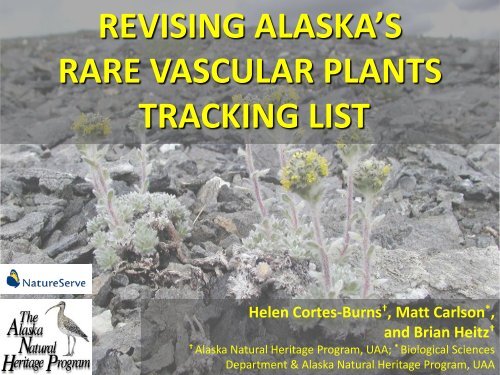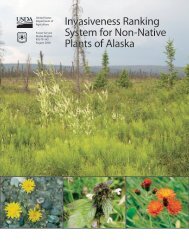Ranking - Alaska Natural Heritage Program
Ranking - Alaska Natural Heritage Program
Ranking - Alaska Natural Heritage Program
You also want an ePaper? Increase the reach of your titles
YUMPU automatically turns print PDFs into web optimized ePapers that Google loves.
REVISING ALASKA’SRARE VASCULAR PLANTSTRACKING LISTHelen Cortes-Burns † , Matt Carlson * ,and Brian Heitz ††<strong>Alaska</strong> <strong>Natural</strong> <strong>Heritage</strong> <strong>Program</strong>, UAA; * Biological SciencesDepartment & <strong>Alaska</strong> <strong>Natural</strong> <strong>Heritage</strong> <strong>Program</strong>, UAA
NatureServe’s <strong>Ranking</strong> MethodologyMertensia drummondii © Jo Overholdt???S2 G2
AKNHP <strong>Ranking</strong> Process: OverviewField data, USFS,NPSpecies, Arctos …Data compilation✔ExpertinputTaxonomic revisions✔Spatially explicit database (GIS)✔ExpertinputRank CalculatorConservation RanksNatureServereview andchangesBIOTICS (statewide rare species’ database)Data requestsstatus reportsRare Plant Field Guide
NatureServe’s <strong>Ranking</strong> Methodology• Non-profit conservation organization• Provides scientific basis for effectiveconservation action• International network of partners• <strong>Heritage</strong> <strong>Program</strong>s & Data Conservation Centers• 50 U.S. states, Canada, Latin America and theCaribbean
NatureServe’s <strong>Ranking</strong> MethodologyObjectives• Transparency• Repeatability• Consistency among and between groups, and across bordersNatureServe’s Rank Calculator• <strong>Ranking</strong> ‘themes’ (3)Rarity – Trends - Threats• <strong>Ranking</strong> factors (10)Help identify specific information gaps-- to direct efforts to increase our knowledge of the speciesand its status assessment
NatureServe’s <strong>Ranking</strong> MethodologyWeighted factors and categories• Premise: “Rarity is the most important, but not sole,influence on extinction probability”• The weights assigned to factors reflect perceivedinfluence on extinction risk• RARITY > TRENDS > THREATS• Population size• Area of occupancy• % occupancy area with ecological integrity• Short term trendsRarity
NatureServe’s <strong>Ranking</strong> MethodologyCategory Factor Factor Type Weight ConditionRARITYRange Extent[disjunct taxa – multiple smallerranges]Area of Occupancy-area within the range that isactually occupiedPopulation Size-Estimated wild population forthe entire range# occurrences[# Elements of Occurrence(1km)]# occurrences or % areawith good ecologicalintegrityCore 1.0Core 2.0Core 2.0Core 1.0Core 2.0Habitat specificity Conditional 1.0Always use, ifavailable.Always use, ifavailable.Always use, ifavailable.Always use, ifavailable.Always use, ifavailable.Only if # occurrencesAND area of occp.UNKNOWN
NatureServe’s <strong>Ranking</strong> MethodologyFactorCategoryTRENDSTHREATSFactor Factor Type Weight ConditionLong termPast 200 yrsShort term(10-100 years)Threat impact(current threats due toanthropogenic actions –none if all occurrences areunder protection)Intrinsic vulnerabilityDegree to which intrinsiccharacteristics make itsusceptible to natural oranthropogenic stressesCore 1.0Core 2.0Core 1.0Conditional 1.0Always use, ifavailable.Always use, ifavailable.Always use, ifavailable.Only use if ThreatImpact isUnknownor Null.
The <strong>Ranking</strong> ProcessRank Calculator FormChange to return GRanks, NRanks, orSranks:Schange using dropdown; alsoaffects Calculator TableSpecies or Ecosystem Scientific NameType(enter "infraspecies" for a T-Rank)Optional Information:Element IDElcodeAmbrosia chamissonisSpeciesglobal, national, orsubnationalCommon NameClassificationVascular PlantCOMMENTS (Placecursor in cell to seefull text.)
Rarityweight: 0.5Rarity1Rarity2X1 Range Extent D2 Area of Occupancy: CDirect estimate(ecosystems) OR4 km 2 grid cells (species)OR1 km 2 grid cells (linearspecies)The <strong>Ranking</strong> ProcessCD = 1,000-5,000 sq km (~400-2,000sq mi)FILL OUT ONLY 1 OFFOLLOWING 3 FIELDSC = 3-5 4-km2 grid cellsc. 2,000 sq km, restricted tocoastal areas in SE AKthe 3 records from AK aredistributed in clusters thatwould occupy 3 distinct 4 sqkm cells1 Number of Occurrences A A = 1 - 5 3 distinct Eos2 Population Size AC AC = 1 - 1000 individuals2BGood Viability/EcologicalIntegrity:Number of OccurrencesORF Percent Area F1Environmental Specificity(opt.)BBBFILL OUT ONLY 1 OFFOLLOWING 2 FIELDSB = Very few (1-3) occurrences withexcellent or good viability orecological integrityF = Excellent percentage (>40%) ofarea with excellent or good viabilityor ecological integrityB = Narrow. Specialist or communitywith key requirements common“rare”, “forming 1-2 sq mpatches where found”coastal beaches (sand,beach meadows, by logs)
The <strong>Ranking</strong> ProcessTrendsThreats0.30.2Trend/ThreatX2 Short-term Trend U U = Unknown1 Long-term Trend U U = Unknown1 Threat Impact U U = Unknown1 IntrinsicVulnerability (opt.)BCBC = Moderately vulnerable tonot intrinsically vulnerablemainly on/near USFSmanaged coastalbeaches …Restricted range andhabitat somewhatvulnerable to majorcatastrophes
The <strong>Ranking</strong> ProcessCalculated Rank S2? Always review the calculated rank.Assigned Rank* S1S2 Adjusted RankRank AdjustmentReasonsAssigned RankReasonsRank AuthorThe rank oscillates from S1 to S2 when one manipulates the factorvaluesslightly (e.g. vulnerability and pop size) compromise onS1S2. Same as 2008 rank.Cortes-Burns, HelenRank Date 27-Apr-2011 Enter Ctrl ; for today's date.Rank CalculatorInternal Notes
ChangesCochlearia sessilifolia @ Stacy StudebakerPapaver maccouniito dateArtemisia senjavinensisPapaver gorodkovii @ Rob Lipkin
2008scientific nameNotable deletions to date2008S, G ranksArnica lessingii ssp. norbergii S2 G5T2Q Arnica lessingiinewscientific nameArtemisia tilesii ssp. unalaschcensis S3 G5T3Q Artemisia tilesii ssp. tilesiiDraba kananaskis S1 G1Q Draba juvenilisBetula papyrifera var. commutata S2 G5T5 environmental variant<strong>Ranking</strong> of additional taxaScientific name• Eritrichium chamissonis ?• Tanacetum bipinnatum ssp. bipinnatum ?• Bidens tripartita?Others?
Taxonomic changes to date2008scientific name2008S, G ranks2011scientific name2011S rankArabis calderi S2 G3G4 Boechera calderi Not reviewedArabis codyi S1 G5 Boechera lemmonii S1S2*Draba lonchocarpavar. vestitaS2? G5T3D. lonchocarpamight be incorporated into D. nivalisNot reviewedDraba paysonii SR G5 D. novolympica SRThlaspi arcticum S3 G3 Noccaea arctica Not reviewedAgoseris aurantiaca S1 G5 A. aurantiaca var. aurantiaca S1S2*Agoseris glauca S2 G5 A. glauca var. dasycephala S3*Cirsium edule S1 G4 C. edule var. macounii S2*Stellaria dicranoides S3 G3 Cherleria dicranoides Not reviewed* (2011) Ranks obtained using the Rank Calculator; pending expert inputSR Species reported but without persuasive documentation
Next steps1. Finish gathering population location datainputneeded!2. Delimit records as ‘Elements of Occurrence’(NatureServe’s conservation unit).3. Calculate ranks for all 2008 tracked species [April - May 2011]4. Receive input on new ranks from experts5. Compile information Re-assess ranksinputneeded!6. Produce a final list of tracked species and ranks [Fall 2011]
Future directions• Upload all records into BIOTICS• Serve “fuzzed” rare plant data onlinehttp://aknhp.uaa.alaska.edu/maps/biotics.php• Update the Rare Plant Field Guide [ongoing]- 70 rare vascular plant taxa- Project funded by the BLM• Develop and implement an‘Annual Data Exchange System’- Similar to AKEPIC, records would be received, qualitycontrolled, and uploaded within a year of receipt• …. Eco-regional ranks?
<strong>Ranking</strong> of additional taxa
AcknowledgementsSpecial thanks to Dave Murray (UAF), Rob Lipkin (Lazy MountainBiological Consulting), Carolyn Parker (UAM), and Bruce Bennett(Environment Yukon) for providing invaluable taxonomic adviceFunding support: the Bureau of Land Management, <strong>Alaska</strong> andthe <strong>Alaska</strong> <strong>Natural</strong> <strong>Heritage</strong> <strong>Program</strong>, UAAWe are grateful to the many peoplethat contribute information on <strong>Alaska</strong>’srare plant populations, among others:• UAM - ARCTOS• Carolyn Parker, UAM• Mary Stensvold, USFS• Brad Krieckhaus, USFS• Mike Duffy• Stacy Studebaker, Kodiak NWRArtemisia globularia var. lutea
















